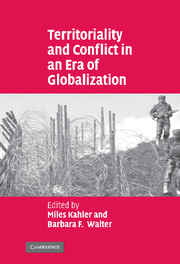Book contents
- Frontmatter
- Contents
- List of figures
- List of tables
- List of contributors
- Acknowledgments
- 1 Territoriality and conflict in an era of globalization
- Part I Territorial attachment and detachment
- Part II Territorial stakes and violent conflict
- 6 Territory and war: state size and patterns of interstate conflict
- 7 Globalization, economic development, and territorial conflict
- 8 The death of distance? The globalization of armed conflict
- Part III Territorial regimes in an era of globalization
- Conclusion
- References
- Index
6 - Territory and war: state size and patterns of interstate conflict
Published online by Cambridge University Press: 22 September 2009
- Frontmatter
- Contents
- List of figures
- List of tables
- List of contributors
- Acknowledgments
- 1 Territoriality and conflict in an era of globalization
- Part I Territorial attachment and detachment
- Part II Territorial stakes and violent conflict
- 6 Territory and war: state size and patterns of interstate conflict
- 7 Globalization, economic development, and territorial conflict
- 8 The death of distance? The globalization of armed conflict
- Part III Territorial regimes in an era of globalization
- Conclusion
- References
- Index
Summary
The average size of states within the international system expanded steadily during the nineteenth century, nearly doubling between 1816 and 1876, and then contracted over the twentieth century. In previous work, we found that two key characteristics of globalization, increasing economies of scale and economic openness, as well as regime type, were important explanations for this trend in average state size (Lake and O'Mahony 2004). The rise in territorial size during the nineteenth century was, in part, the product of a growing number of large, federal democracies made possible by increasing economies of scale, while economic liberalism allowed small, unitary democracies to prosper in the twentieth century.
In this chapter, we analyze how this trend in average state size affects interstate conflict. We predict that as average state size increased in the nineteenth century, larger national territories will become more valuable, leading to more interstate territorial disputes. Conversely, as average state size declined in the twentieth century, we expect interstate conflict to decline. Testing this hypothesis at both the systemic and the regional level, we find relatively strong support for this expectation in the pattern of interstate wars and in the issues underlying those conflicts.
We first summarize our earlier investigation into the patterns and causes of average state size since 1815. The second section section develops our theory of average state size and conflict, and the third section reviews the empirical evidence. In the fourth section, we examine changes in the issues that led to interstate war.
- Type
- Chapter
- Information
- Territoriality and Conflict in an Era of Globalization , pp. 133 - 155Publisher: Cambridge University PressPrint publication year: 2006
- 6
- Cited by



